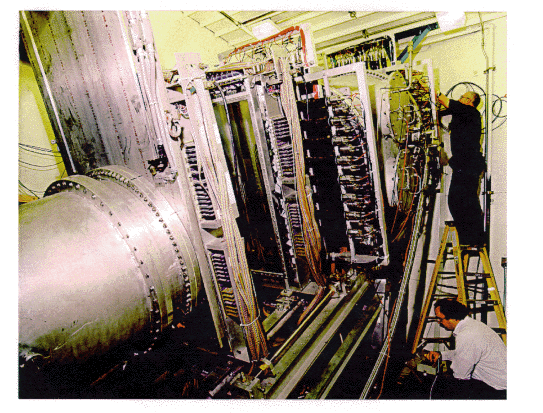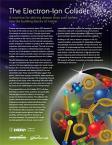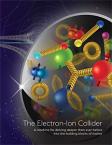JEFFERSON LAB SEARCH
Goals
There are many scientific questions that researchers expect an Electron-Ion Collider will allow them to answer. Among them are four main topics of study.
 3D Structure of Protons and NucleiScientists would use the Electron-Ion Collider to take three-dimensional precision snapshots of the internal structure of protons and atomic nuclei. As they pierce through the larger particles, the high-energy electrons will interact with the internal microcosm to reveal unprecedented details—zooming in beyond the simplistic structure of three valence quarks bound by a mysterious force. Recent experiments indicate that gluons—the glue-like carriers of the strong nuclear force that binds quarks together—multiply and appear to linger within particles accelerated close to the speed of light, and play a significant role in establishing key properties of protons and nuclear matter. By taking images at a range of energies, an EIC will reveal features of this “ocean” of gluons and the “sea” of quark-antiquark pairs that form when gluons split—allowing scientists to map out the particles’ distribution and movement within protons and nuclei, similar to the way medical imaging technologies construct 3D dynamic images of the brain. These studies may help reveal how the energy of the massless gluons is transformed through Einstein’s famous equation, E=mc2, to generate most of the mass of visible matter.
3D Structure of Protons and NucleiScientists would use the Electron-Ion Collider to take three-dimensional precision snapshots of the internal structure of protons and atomic nuclei. As they pierce through the larger particles, the high-energy electrons will interact with the internal microcosm to reveal unprecedented details—zooming in beyond the simplistic structure of three valence quarks bound by a mysterious force. Recent experiments indicate that gluons—the glue-like carriers of the strong nuclear force that binds quarks together—multiply and appear to linger within particles accelerated close to the speed of light, and play a significant role in establishing key properties of protons and nuclear matter. By taking images at a range of energies, an EIC will reveal features of this “ocean” of gluons and the “sea” of quark-antiquark pairs that form when gluons split—allowing scientists to map out the particles’ distribution and movement within protons and nuclei, similar to the way medical imaging technologies construct 3D dynamic images of the brain. These studies may help reveal how the energy of the massless gluons is transformed through Einstein’s famous equation, E=mc2, to generate most of the mass of visible matter. Solving the Mystery of Proton SpinThe Electron-Ion Collider would be the world’s first polarized electron-proton collider where both the electron and proton beams have their spins aligned in a controllable way. This polarization makes it possible to make precision measurements of how a proton’s constituent quarks and gluons and their interactions contribute to the proton’s intrinsic angular momentum, or spin. Spin influences the proton’s optical, electrical, and magnetic characteristics and makes technologies such as MRI scanning work, but its origin has eluded physicists ever since experiments in the 1980s revealed that quarks can account for only about a third of the total spin. More recent experiments show that gluons make a significant contribution, perhaps even more than the quarks. An Electron-Ion Collider would produce definitive measurements of the gluons’ contributions, including how their movements within the proton microcosm affect its overall spin structure—thus providing the final pieces needed to solve this longstanding puzzle.
Solving the Mystery of Proton SpinThe Electron-Ion Collider would be the world’s first polarized electron-proton collider where both the electron and proton beams have their spins aligned in a controllable way. This polarization makes it possible to make precision measurements of how a proton’s constituent quarks and gluons and their interactions contribute to the proton’s intrinsic angular momentum, or spin. Spin influences the proton’s optical, electrical, and magnetic characteristics and makes technologies such as MRI scanning work, but its origin has eluded physicists ever since experiments in the 1980s revealed that quarks can account for only about a third of the total spin. More recent experiments show that gluons make a significant contribution, perhaps even more than the quarks. An Electron-Ion Collider would produce definitive measurements of the gluons’ contributions, including how their movements within the proton microcosm affect its overall spin structure—thus providing the final pieces needed to solve this longstanding puzzle. Search for SaturationCapturing the dynamic action of gluons within protons and nuclei will give scientists a way to test their understanding of these particles’ ephemeral properties. As gluons flit in and out of the vacuum, multiplying and recombining, scientists suspect they may reach a steady state of saturation called a “color glass condensate.” This unique form of nuclear matter gets its name from the “color” charges that mediate the interactions of the strong nuclear force, and the dense, glasslike walls these particles are thought to form in nuclei accelerated to nearly the speed of light, seemingly suspended by the effects of time dilation. Scientists will use the Electron-Ion Collider to search for definitive proof of whether this form of matter exists, and test the limits of gluons’ ability to expand beyond the bounds of a single proton/ neutron inside a nucleus. They’ll also explore the mechanism that keeps gluon growth in check, like a lid clamping down on an overflowing popcorn pot. Precisely measuring the strength of the gluon fields, which constitute the strongest fields found in nature, will tell us how gluons interact with each other and how they contribute to building the bulk of visible matter in the universe today.
Search for SaturationCapturing the dynamic action of gluons within protons and nuclei will give scientists a way to test their understanding of these particles’ ephemeral properties. As gluons flit in and out of the vacuum, multiplying and recombining, scientists suspect they may reach a steady state of saturation called a “color glass condensate.” This unique form of nuclear matter gets its name from the “color” charges that mediate the interactions of the strong nuclear force, and the dense, glasslike walls these particles are thought to form in nuclei accelerated to nearly the speed of light, seemingly suspended by the effects of time dilation. Scientists will use the Electron-Ion Collider to search for definitive proof of whether this form of matter exists, and test the limits of gluons’ ability to expand beyond the bounds of a single proton/ neutron inside a nucleus. They’ll also explore the mechanism that keeps gluon growth in check, like a lid clamping down on an overflowing popcorn pot. Precisely measuring the strength of the gluon fields, which constitute the strongest fields found in nature, will tell us how gluons interact with each other and how they contribute to building the bulk of visible matter in the universe today. Quark and Gluon ConfinementExperiments at an EIC would offer novel insight into why quarks or gluons can never be observed in isolation, but must transform into and remain confined within protons and nuclei. The EIC—with its unique combinations of high beam energies and intensities—would cast fresh light into quark and gluon confinement, a key puzzle in the Standard Model of physics.
Quark and Gluon ConfinementExperiments at an EIC would offer novel insight into why quarks or gluons can never be observed in isolation, but must transform into and remain confined within protons and nuclei. The EIC—with its unique combinations of high beam energies and intensities—would cast fresh light into quark and gluon confinement, a key puzzle in the Standard Model of physics.About
The Electron-Ion Collider is a proposed machine for delving deeper than ever before into the building blocks of matter, so that we may better understand the matter within us and its role in the universe around us.
Learn more about this first-of-its-kind machine in the documents linked below.
-
Year Title Experiment Spokesperson
2010-2012Qweak E08-016 Carlini, Finn, Kowalski, Page -
-
-
Features:
- Conservative Superconducting Cold Fe Design
- Q2 & Q3 are Identical & Cryostable
- Multipole Windings
Specifications:
Q1 Q2/Q3 Gradient 605 G/cm 445 G/cm "Good Field" Radius 22 cm 30 cm Pole Tip Field 1.5 T 1.56 T Radius to Pole -
Features:
- Flat Racetrack, Cryostable Coils
- No Negative Curvature on Coil
- Graded Air Gap
- Flat Poles
- All Yoke Pieces <20 tons
Specifications:
Gap 421 cm Good Field Width +/- 30 cm Bend Angle 25o Max. Pole Tip Field 1.66 T (6 GeV/c) Dynamic Field Range 10:1 Field Uniformity B/B -
Performance of HMS Studied for Two Tunes:
Parallel ⇒ Point Best in plane angle accuracy. Point ⇒ Point Best vertex reconstruction. HMS Transmission Efficiency Studied as Functions of:
- Target location offsets
- Momentum offsets
-
OPTICS TUNE:PARALLEL-PTPT-PT
MOMENTUM:
Maximum Central Momentum
Momentum Bite[(Pmax-Pmin)/P0]
Momentum Resolution delta p/p7.5 GeV/c
18%
<0.1%7.5 GeV/c
18%
<0.1%ACCEPTANCES:
Solid Angle
Min. Central Scattering Angle
>6 msr
12.5o
>6 msr
12.5oAngle Measurement PrecisionIn Scattering Plane
Out-of-Plane -
Pictured is the Hall C detector for the High Momentum Spectrometer (HMS). Contained in a concrete shield house, this detector is used for particle identification after the beam hits the target and the scattered particles are focused onto this detector . The detector contains several instruments that measure different elements of the particles including: drift chambers, hodoscopes, and gas and lead-glass Cerenkov detectors.






